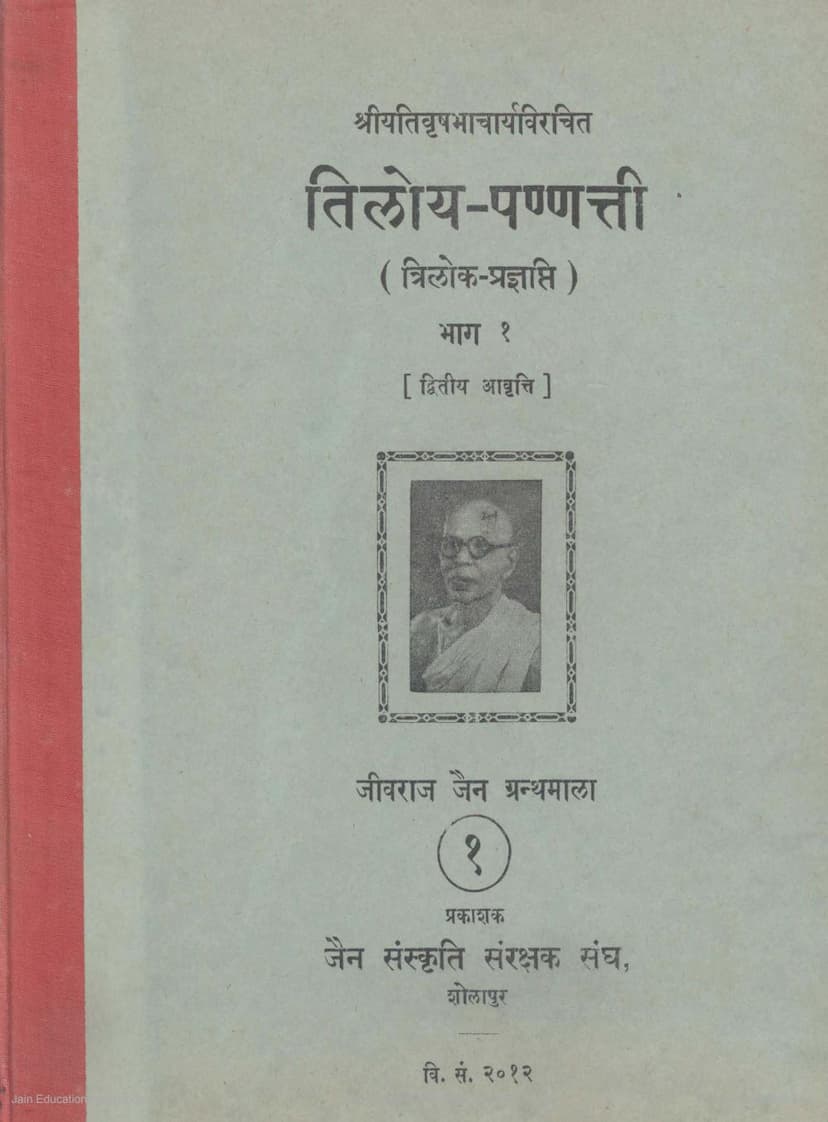Tiloy Pannati Part 1
Added to library: September 2, 2025

Summary
Summary of Tiloy Pannati Part 1
This comprehensive summary covers the content of the first part of "Tiloy Pannati" (also known as Trilok Prajnapti), an ancient Prakrit text on Jain cosmology, dogmatics, mythology, and chronology. Authored by Jadivasaha (Yativrishabha) and published by the Jaina Sanskruti Samrakshak Sangh, Sholapur, the work is a foundational text in Jain literature.
Overview:
"Tiloy Pannati" (TP) is a significant ancient Jain text that delves into the intricacies of Jain cosmology. It provides detailed descriptions of the three worlds (Tiloy), the various realms within them, the celestial beings residing there, and the cyclical nature of time according to Jain philosophy. The text is highly technical and uses complex mathematical and astronomical concepts to explain the structure and functioning of the universe as understood by the Digambara Jain tradition.
Key Themes and Content:
The book, as indicated by the table of contents, is structured into several major sections or "Mahadhikaras." Based on the provided text, particularly the table of contents and prefaces, the first part of Tiloy Pannati (Part 1) focuses on the initial "Mahadhikaras," likely covering foundational aspects of the Jain worldview.
1. Cosmography and Structure of the Universe:
- Three Worlds (Trilok): The text meticulously describes the division of the universe into the lower world (Adholok), the middle world (Madhyalok), and the upper world (Urdhvalok).
- Dimensions and Geometry: TP explains the dimensions of the universe, including concepts like rajju (a unit of measure equivalent to the distance light travels in six months), pratarangul (a unit of measure for spatial extent), and ghanangul (a unit of volume). The text details the geometric shapes of different parts of the universe, such as the vetrasana (cane seat) shape of the lower world and the mridanga (drum) shape of the middle and upper worlds.
- Specific Regions: It describes the seven earth strata of the lower world (Ratnaprabha, Sharkara, Balu, Pank, Dhuma, Tama, Mahutama), the location and characteristics of hellish beings (naraka), and the distribution of their residences (bila).
- Jambudvipa: The text provides an exhaustive description of Jambudvipa, the central continent in the middle world, including its dimensions, the surrounding continent-ocean (lavana samudras), its mountain ranges (kula parvatas), rivers, and the cities and residences of various beings.
- Loka Lokayata: The relationship between the occupied (lokakasa) and unoccupied (alokakasa) space is explained.
- Cosmic Cycles: The text touches upon the cyclical nature of time, including avasarpini (descending era) and utsarpini (ascending era), and their subdivisions.
2. Dogmatics and Jain Philosophy:
- Six Substances (Dravyas): While not explicitly detailed in the preface, the foundational Jain concept of six substances (jiva, pudgala, dharma, adharma, akasa, kala) is the underlying framework for the entire cosmology.
- Karma: The text indirectly refers to karma as "mal" (impurities) that needs to be removed, and mentions the concept of karma bandha (binding of karma) and nirjara (shedding of karma).
- Causality and Logic: The text emphasizes the importance of pramana (means of knowledge), naya (standpoints), and nikshepa (classification) in understanding the universe, highlighting how understanding these is crucial for proper cognition.
- Virtues and Conduct: The preface mentions the importance of the pancha mahavratas (five great vows) for ascetics, and the need for virtuous conduct in life, exemplified by the life and philosophy of Brahmachari Jivaraj Gautamchand Doshi, the sponsor of the publication.
3. Mythology and Chronology:
- Celestial Beings: TP describes the various classes of celestial beings (devas), their residences (mansions, palaces), their lifespans, their powers, and their roles in the universe. This includes detailed accounts of the Bhavanavasis (earthly dwellers), Vyantaras (those who move between worlds), Jyotishis (celestial luminaries), and Kalpavasis (heavenly dwellers).
- Tirthankaras and Chronology: The text also mentions the lineage and lives of the Tirthankaras, providing details about their birth, lifespans, ascetics, and the times of their nirvana. This section highlights the importance of chronological order in Jain history and cosmology. The preface also pays tribute to the editors and the publisher for their dedication to bringing this ancient work to light, emphasizing the challenges faced in editing and publishing such a complex text.
4. Editorial and Publishing Aspects:
- Authentic Editing: The preface stresses the effort to provide an authentic edition based on various manuscript readings. The editors acknowledge the difficulties in restoring the text due to corrupt manuscripts and the obscure nature of the subject matter.
- Hindi Paraphrase: The inclusion of a Hindi paraphrase by Pt. Balchandra Siddhantasastri makes the complex Prakrit text more accessible to a wider audience.
- Jivaraj Jain Granthamala: The publication is part of the "Jivaraj Jain Granthamala," a series dedicated to preserving and disseminating ancient Jain scriptures, made possible by the munificence of Brahmachari Jivaraj Gautamchand Doshi.
Overall Significance:
"Tiloy Pannati" is a monumental work that provides a systematic and comprehensive understanding of Jain cosmology. It is essential for anyone studying Jain philosophy, astronomy, or the history of religious thought in India. Part 1 lays the groundwork for this understanding by detailing the fundamental structure of the universe and the principles governing it, as envisioned by ancient Jain scholars. The meticulous editing and translation efforts ensure that this vital text is available for scholarly and personal study.